Request for Proposal/Quotation
Introduction/Purpose:
A Request for Proposal (RFP) and Request for Quotation (RFQ) are formal documents that organizations use to solicit proposals or quotations from potential vendors. Both RFP and RFQ are used to initiate a procurement process where the organization intends to purchase goods or services from a supplier.
An RFP is a document that outlines the organization’s requirements, specifications, and evaluation criteria for a particular project. The RFP is used when the organization seeks to purchase complex or technical products or services, and a detailed proposal is required from the vendors. The RFP typically includes information on the project’s objectives, scope, budget, timelines, terms and conditions, and any other relevant information that will help the vendors prepare a proposal that meets the organization’s needs.
On the other hand, an RFQ is a document that solicits quotations from potential vendors for a particular product or service. The RFQ is used when the organization seeks to purchase simple or standardized products or services, and a detailed proposal is not required. The RFQ typically includes information on the product or service required, the quantity needed, delivery timelines, terms and conditions, and any other relevant information that will help the vendors prepare a quotation that meets the organization’s needs.
Overall, the RFP/RFQ entry in a procurement system plays a critical role in ensuring that the organization obtains quality goods or services at the best possible price, with transparency and fairness in the procurement process.
Dependency:
To record transactions of a Request for Proposal (RFP) and Request for Quotation(RFQ), a dependency exists between various elements involved in the process. The key components that require recording include material selection, security terms, vendor selection, and payment terms.
- Material selection: The materials can be selected from the requisition list, or the user can add materials manually. It is essential to record the materials selected and their respective quantities to ensure proper procurement and delivery.
- Security terms: This involves specifying the type of security document required and the amount of security. The security document serves as a guarantee from the vendor that they will fulfill the terms of the contract. Recording this information ensures that both parties are aware of their obligations and can act accordingly.
- Vendor selection: This process requires recording the vendors invited and their respective proposals. Recording this information is crucial in evaluating the vendors’ proposals and selecting the most suitable vendor.
- Payment terms: This involves defining the payment plan and how the payment will be made. Recording this information is necessary to ensure that the payment is made according to the agreed-upon terms and that both parties are aware of the payment schedule.
Overall, recording the transactions of the RFP and RFQ process is essential to ensure proper procurement, delivery, and payment. The dependency between the various elements involved highlights the importance of recording each aspect accurately to ensure a successful project outcome.
Process Flow:

How To Navigate:
The navigation to record an RFP/RFQ in a procurement system typically involves the following steps:
- Click on the main navigation icon: The main navigation icon may be located in the top right corner of the screen. Clicking on this icon will open the navigation menu, which typically includes links to various sections of the procurement system.
- Click on the transaction section: The transaction section is located under the left section of the screen clicking on this section will display a list of transactions related to procuring.
- Find the Quotation / Proposal section: The Quotation / Proposal section is located in the list of transactions under the transaction section. Clicking on this section will display a list of transactions related to Quotation / Proposal.
- Click on the Request for Proposal/ Request for Quotation link: The Request for Proposal/ Request for Quotation link is located under the Quotation / Proposal section, after clicking on this link you can navigate Request for Proposal/ Request for Quotation listing and from that you can easily upload new transactions into the system.
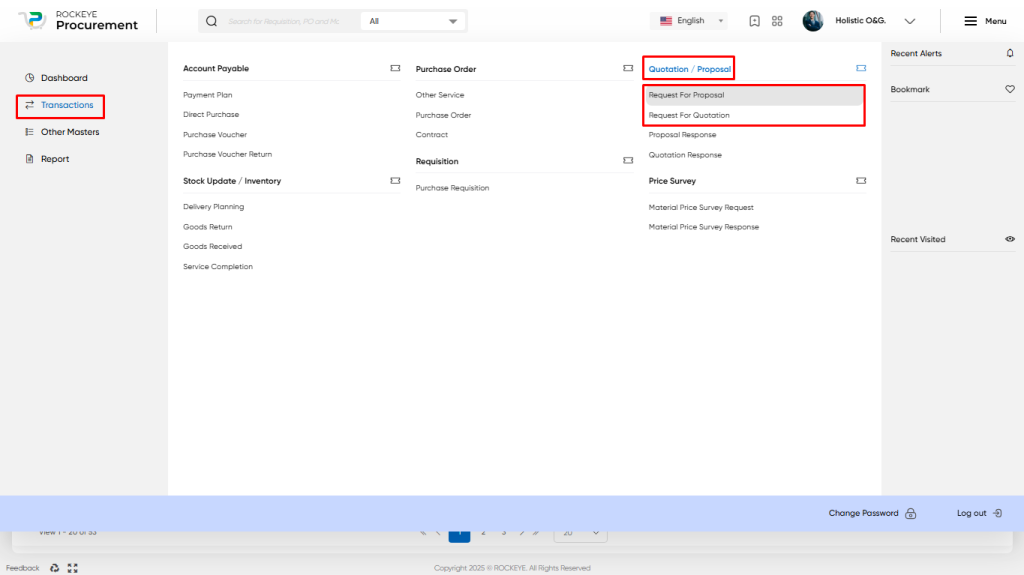
Listing:
The Request for Proposal/ Request for Quotation listing is an essential feature of a procurement system that allows users to view and manage all recorded Request for Proposal/ Request for Quotation. The key features of the Request for Proposal/ Request for Quotation listing include:
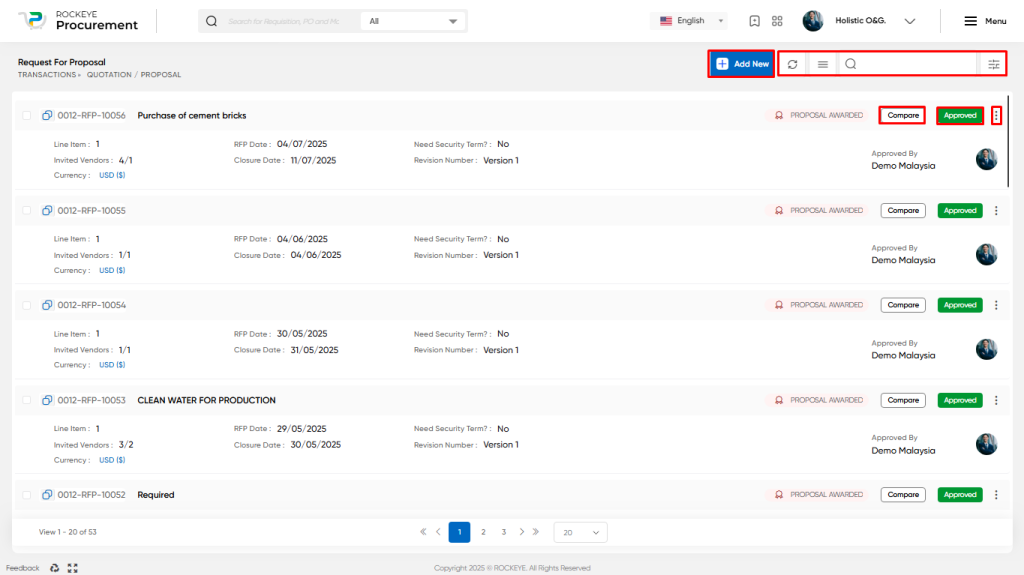
- Record Filter The Request for Proposal/ Request for Quotation listing may include a filter option that allows users to filter the list of RFP/RFQ based on specific criteria, such as date range, Currency, vendor name, or approval status.
- Transaction Search The Request for Proposal/ Request for Quotation listing may include a search function that allows users to search for specific RFP/RFQ by transaction number, or other keywords.
- Export transaction The RFP/RFQ listing may include an export transaction option that allows users to export the list of RFP/RFQ to a spreadsheet or other file format for further analysis or reporting.
- Extended features for each transaction The RFP/RFQ listing includes extended features for each transaction such as print, view, Email, Activity log, tracking history, Add Vendor Response, Create Contract, View Ticket, and more.
- Listing view The RFP/RFQ listing may display each transaction in a card format view that includes key information such as Document number, No of Invited Vendors, Closer date, Security required, No of Revision, Currency, Approval authority name, Proposal Awarded, Compare, and approval status of the transaction.
- Compare: The option to compare invited vendors’ responses for proposals or quotations allows buyers to evaluate and compare each vendor’s proposed solution or pricing in a standardized way. This helps the buyer make an informed decision and select the best vendor for their needs.
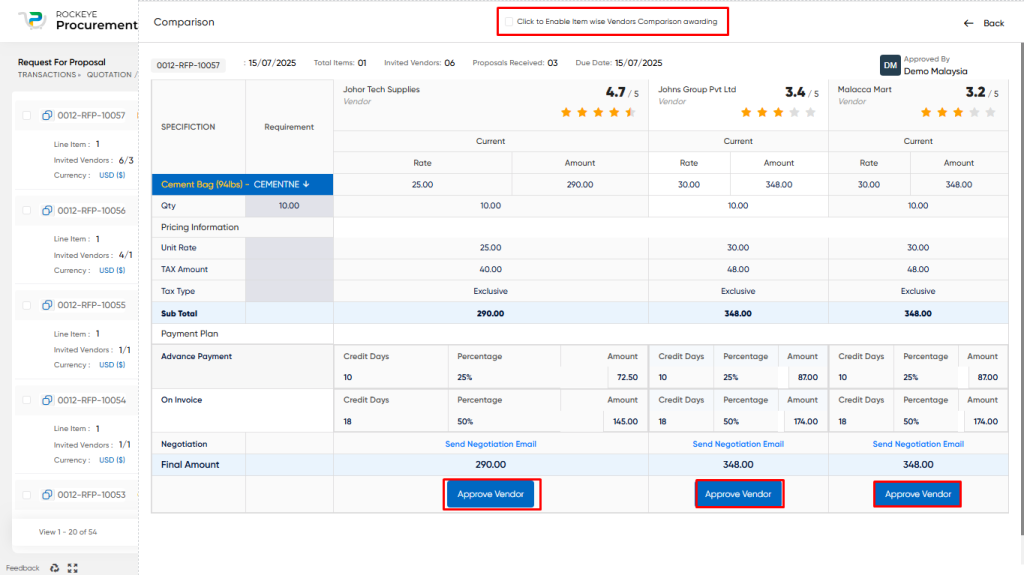
- Approval status: The RFP/RFQ listing displays the approval status of each transaction, indicating whether it has been approved or not.
In summary, the RFP/ RFQ listing is a crucial feature of a procurement system that provides users with an overview of all recorded RFP/RFQ and allows them to filter, search, export, and manage the Proposal / Quotation efficiently. It also includes extended features for each transaction and displays key information such as Approval status, Awarded Status in a card format view.
Recording & Update:
RFP/RFQ recording and updating transactions are important steps in the procurement process to keep track of all communication and documentation related to the procurement.
In the procurement flow, the process starts with a purchase requisition, which is a document that specifies the goods or services required by the buyer The procurement team then selects vendors to invite for the RFP/RFQ process based on various factors such as the vendor’s experience, capability, pricing, and delivery terms. The selected vendors are then invited to submit their proposals or quotations.
In the case of off-the-shelf procurement, where there is no user requisition, the procurement team can directly select the required material and ask for quotations or proposals from the vendors. In this case, the recording and updating of transactions are even more important, as all communication and documentation related to the procurement will need to be tracked and maintained.
Overall, recording and updating transactions throughout the procurement process is crucial to ensure transparency, accountability, and effective management of the procurement process.
The RFP / RFQ entry into a procurement system is typically divided into three parts which are mentioned below.
Basic Information
The first part of the RFP / RFQ entry displays information related to the transaction, this will include below fields
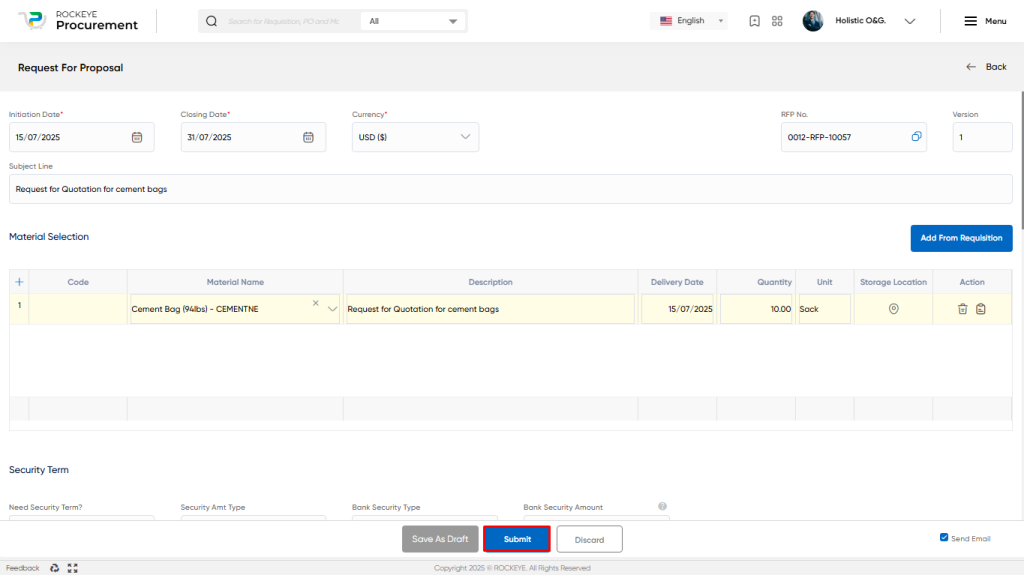
- Initiate Date: This field refers to the date on which the request for proposal (RFP) or request for quotation (RFQ) was initially created or initiated by the organization or company that is seeking proposals or quotations from potential vendors or suppliers.
- Closing Date: This field refers to the date on which the submission of proposals or quotations is due. It is the deadline by which interested vendors or suppliers must submit their proposals or quotations to the organization or company.
- Currency: This field refers to the type of currency that will be used to evaluate the proposals or quotations received from potential vendors or suppliers. It is important to specify the currency upfront to avoid confusion or misunderstandings later on.
- Document Number: This field refers to the unique identifier assigned to the RFP or RFQ document. It is typically a sequential number or a combination of letters and numbers that helps to identify and track the document throughout the procurement process.
- Version: This field refers to the version number or revision level of the RFP or RFQ document. It is important to include this information to ensure that all interested vendors or suppliers are working with the same version of the document and that any updates or changes are clearly communicated.
- Subject Line: This field refers to the brief description or title of the RFP or RFQ document. It should clearly and concisely convey the purpose and scope of the procurement opportunity to potential vendors or suppliers.
Material / Service Information
The second part of the RFP / RFQ entry displays information related to the items purchased, this will include the below fields

- Code This field refers to the unique identifier or code assigned to a particular material or item that is being requested in the RFP or RFQ.
- Material Name This is the name of the material or service being required.
- Description This field will describe the about Item being requested.
- Delivery Date The Expected Date in a Purchase Requisition refers to the date by which the department expects to receive the requested goods or services.
- Quantity This is the quantity of the material or service that is Requested by the user.
- Unit a Unit refers to the specific unit of measurement that is used to quantify the goods or services being requested
- Storage Location This includes additional information about the material or service being requisition, such as specifications or delivery location.
- Action buttons These buttons provide the functionality to remove or add a line item.
Overall, the middle section of an RFP/RFQ provides detailed information about the goods or services being requested, Qty, Location, and other relevant details.
Summary Information
The third part of the RFP/RFQ entry provides a summary of the transaction and shows below information and some additional information that is related to the transaction.
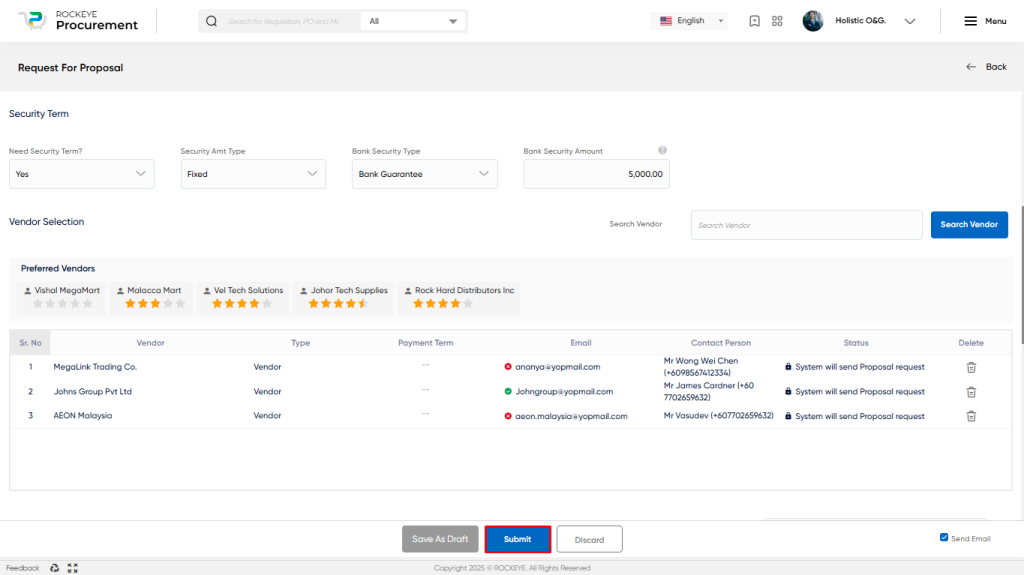
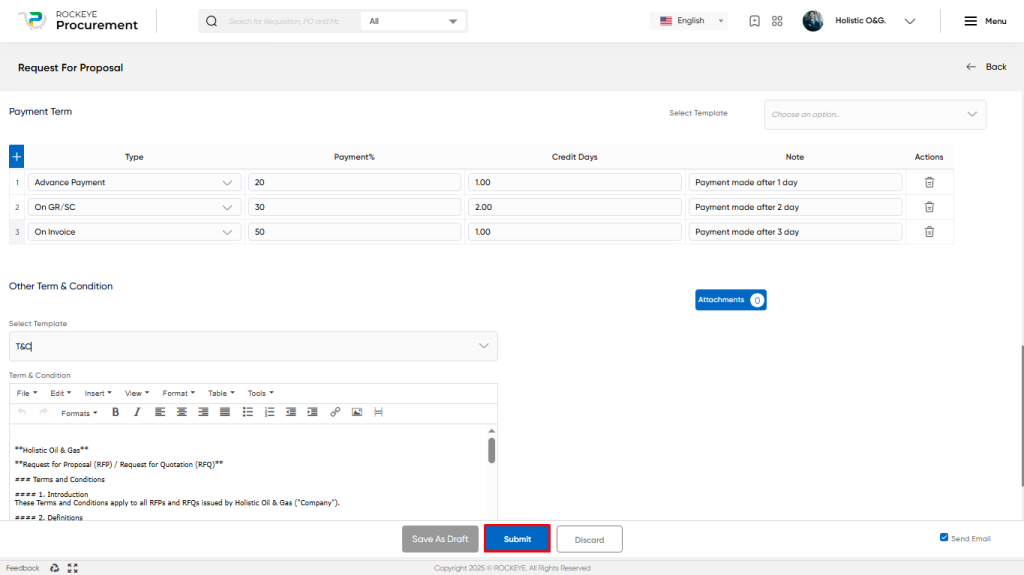
- Security Term: Security terms in a Request for Proposal (RFP) or Request for Quotation (RFQ) refer to any requirements related to security deposits or performance guarantees that may be required from potential bidders. The purpose of these security terms is to provide assurance to the issuing organization that the successful bidder will be able to fulfill their obligations under the contract.
- Vendor Selection: Vendor selection in a Request for Proposal (RFP) or Request for Quotation (RFQ) is a critical process that involves evaluating bids received from potential vendors to determine the most suitable candidate to fulfill the procurement opportunity.
- Payment Term: Payment terms in a Request for Proposal (RFP) or Request for Quotation (RFQ) typically outline the payment schedule and conditions for a procurement opportunity. The payment terms are an important aspect of the procurement process as they define how and when the vendor will be paid for their goods or services.
- Users can add an Other Term & Condition for the RFP/RFQ from Set Template which will reflect in the respective document.
- Attachment This field allows the user to upload any invoice copy or other documents related to the purchase.
The user can perform the following actions in this section:
- Save as Draft: This option allows the user to save the transaction information in draft mode and publish it later. This is helpful if the user wants to review the information before submitting it for approval.
- Submit: This option allows the user to publish the transaction information. If the system has an approval flow, the maker will submit the information, and it will be sent to the approval authority or checker for approval.
- Discard: This option allows the user to discard the transaction before saving it.